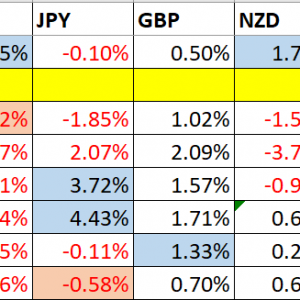Latest Posts
-
Finance 0
Crude Oil Looks To Weaken Further
Crude oil: The commodity continues to hold on to its downside pressure leaving risk of more strength on the cards. On the downside, support resides at the 30.00 level where a break will expose the 29.00 level. A cut through here will set the stage for a run at the 28.00 level. Further down, support resides at the 27.00 level. Its daily RSI is bearish and pointing lower suggesting further weakness. On the upside, resistance resides at the 32.00 level. Further out, resistance comes in at the 33.00 level. A break above here will aim at the 34.00 level and then the 35.00 level followed by the 36.00 level. All in all, Crude oil’s broader bia...On February 7, 2016 / By Kurt Osterberg -
Finance 0
China Blows Another $99 Billion Of Reserves In January: Yuan Intervention And Results In Pictures
China has blown about $1 trillion in US reserves defending the yuan from capital flight in the last year. Nearly $100 billion of that reserve outflow came in January. Let’s s take a look at the results in pictures. Intervention Results in Pictures Interventions Don’t Work From 6.214 to 6.569 is a 5.4% decline in the yuan relative to the US dollar since August. China’s intervention has not accomplished much of anything other than blowing currency reserves. In general, currency interventions don’t work. China’s Dwindling Reserves The BBC reports China’s Currency Reserves Plunged in January China has been running down its vast forei...On February 7, 2016 / By Kurt Osterberg -
Finance 0
E 2008 Redux?
There is much talk about 2008 and many comparisons between then and now. It has been my experience that most of the pundits who shout: “2008!” have little knowledge and even less understanding of what caused the Financial Crisis. Ask them to describe what a SIV, CDO, Synthetic CDO and CDO-squared are, chances are you will get a blank stare in response. That stare is usually indicative of their knowledge of the subject. (4) (5) (6) (7) Fixed income market pundits often discuss risk premiums (credit spreads) to judge relative value. If risk premiums are narrower than the historic average, credit products, such as corporate and municipal bon...On February 7, 2016 / By Kurt Osterberg -
Finance 0
E Negative Interest Rates And Why Banks Want Fannie And Freddie
Here are some cutting edge discussions about negative interest rates (NIRP) that are worth your attention. Some of the discussions speak to profound insights gained, and others speak to tweaks needed to fully embrace the negative rate regimes. Others discuss the success or failure of such regimes. Why banks may want to replace Fannie and Freddie so badly is discussed. Bookmark this page as a reference to these ongoing discussions. The assumption of those seeking negative rates is that they will serve as a stimulant to economic growth and a stimulant to mild inflation that would stimulate growth. So far there is little evidence that these meas...On February 7, 2016 / By Kurt Osterberg -
Finance 0
Protect Yourself From China’s Currency Contagion
Mainstream economists and media pundits have been telling people that problems in China are unlikely to cause serious problems in the United States. They point to the fact that China only accounts for a small percentage of U.S. trade, for example, and that the falling Chinese stock market has very little to do with our stock market. Unfortunately, they are missing the point. China is now to the rest of the world what the U.S. housing market was before the 2008 financial crisis – it is the epicenter of global instability. And at the very heart of that instability lies the yuan. Western investors may not realize that the yuan has apprecia...On February 7, 2016 / By Kurt Osterberg -
Finance 0
WTI Vs. OPEC – The War Of Attrition Is Coming To A Head
The global oil supply finds itself at a precarious predicament at this point in time. We have OPEC and non-OPEC countries competing with one another for market share at the expense of profitability and demand/supply equilibrium. What was once an industry characterised by $115 per barrel of crude oil is now an industry where $30 per barrel or less for crude oil is a reality. This has far reaching ramifications for major oil producers across the world. As can be seen from the above chart, onshore Middle East producers are in the best possible position to supply crude oil at current prices. But more importantly, countries in the Middle East wh...On February 7, 2016 / By Kurt Osterberg -
Finance 0
The Number Everyone’s Been Waiting For: Chinese Reserves Plunge By $100BN – What Does It Mean For Markets?
As we previewed on Thursday, the biggest event of the week, and perhaps of the month, was not Friday’s nonfarm payroll report, but the January update of China’s FX reserves, relesed by the PBOC. The number came out at $3.2309 trillion, down $99.5 billion from the prior month, and $8 billion less than the December outflow of $107.6 billion. And even as China added $3.4 billion to its gold reserves, which rose to $63.6 billion or an increase of half a million ounces to 56.66 million, this reduced the total amount of Chinese foreign reserves to the lowest level since May 2012, and down from the $4 trillion peak in the summer of 2014...On February 7, 2016 / By Kurt Osterberg -
Finance 0
Easing Of US Recession Fears Will Likely Lend Dollar Support
With many equity markets having fallen 20% from their peaks, meeting a common definition of a bear market, investors, analysts, and journalists understandably seek a narrative that gives it meaning. At the very start of the year, the culprit singled out was drop in Chinese shares and the yuan. However, the yuan has stabilized as the PBOC drew down another $100 bln of reserves in January to help ease the pressure what appears to at least in part be a speculative attack by hedge funds (who conclude the yuan is overvalued). Some narratives attributed the market turmoil to the drop in oil prices. From the end of 2015 through January 20, the ...On February 7, 2016 / By Kurt Osterberg -
Finance 0
These Catalysts Could Easily Lead To A Market Crash In 2016
By Damon Verial [In this article I don’t predict]…a hard date or magnitude of the next market crash…[but] merely point out that there are several catalysts [as discussed below] that could easily lead to a large market crash in 2016. The Cyclical Nature of the Market One of my main complaints about buy and hold investors is that they fail to recognize the cyclical nature of the stock market, of industries, and of their individual holdings. Just as we know that International Business Machines (IBM) consistently underperforms during Q1 and Q2, we know things about the wider market as a whole. For example, every seven or eigh...On February 7, 2016 / By Kurt Osterberg -
Finance 0
Trading Support And Resistance
This week we’ll begin with our monthly and weekly forecasts of the currency pairs worth watching. The first part of our forecast is based upon our research of the past 11 years of Forex prices, which show that the following methodologies have all produced profitable results: * Trading the two currencies that are trending the most strongly over the past 3 months. * Assuming that trends are usually ready to reverse after 12 months. * Trading against very strong counter-trend movements by currency pairs made during the previous week. * Buying currencies with high interest rates and selling currencies with low interest rates. Let’s take a...On February 7, 2016 / By Kurt Osterberg
Top Posts
-
 The Importance for Individuals to Use Sustainable Chemicals
The Importance for Individuals to Use Sustainable Chemicals
-
 Small Businesses: Finding the Right Candidate for the Job
Small Businesses: Finding the Right Candidate for the Job
-
 How to Write the Perfect Thank You Letter After Your Job Interview
How to Write the Perfect Thank You Letter After Your Job Interview
-
 3 Best Large-Cap Blend Mutual Funds For Enticing Returns
3 Best Large-Cap Blend Mutual Funds For Enticing Returns
-
 China suspected in massive breach of federal personnel data
China suspected in massive breach of federal personnel data













